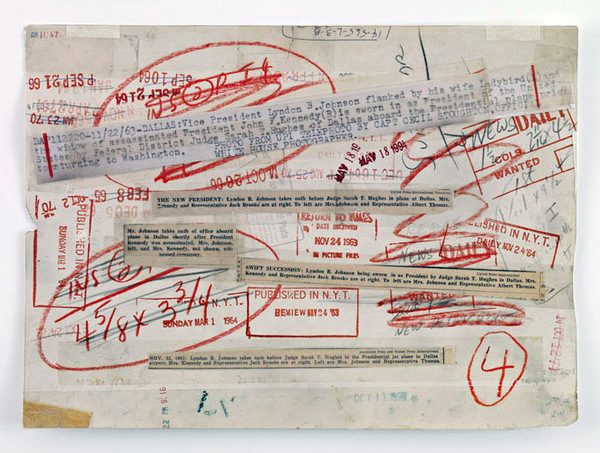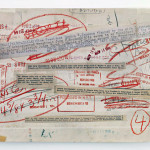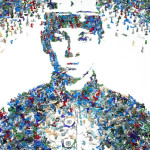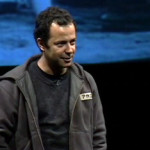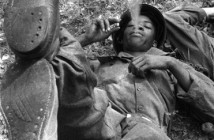AN INTERVIEW WITH VIK MUNIZ
Vik Muniz was in Boston recently for two sold-out lectures at the MFA. Jeffrey Keough, former Director of Exhibitions at the Massachusetts College of Art & Design and I had the opportunity to spend the latter part of the Wednesday, April 15th with Mr. Muniz. Here are some questions transcribed from the recorded interview.
*
Jason Landry: You make the subjects that you photograph, as opposed to finding them. How has that expanded or constricted what you say?
Vik Muniz: I don’t know if finding and making has a significant difference. If you are looking for it, there is al lot of making in that process as well. I don’t think that subjects just fall in your hands for absolutely no reason. People usually think that my work is harder than the regular photographer, which I think it quite the opposite. I facilitate the process, instead of going out and trying to find it. There is an interesting metaphor in Chinese scholars’ rocks. The artist is out there and not making anything. He is looking for a shape in a rock that can somehow translate a feeling or a sensation or a mood and a philosophy of what he’s trying to say. Once he finds that object, he finds a way to present it. It is interesting to see what is found and what is made. You only find things you are looking for. It’s impossible to find something you are not looking for. The other part of the work is finding ways to present it.
JL: Is there a work of art that continues to inspire you?
VM: It would be very hard to mention one particular work of art. I am inspired by works of art but also by things of the mundane kind. I am very inspired by painting. I’m married to a painter…I watch her paint. Painting takes a lot of skill. You have to put down your pride. As a photographer, sculptor and one who draws, I could never paint. I’ve tried several times but it is something I cannot do. And maybe that’s the reason why I have so much respect for it. You have to start something out of nothing. I need a few clues of something there for me to work with. Starting with just a blank canvas is very hard to imagine for me. When you look at a painting, it’s an arrangement of very simple things. It is mostly stuff that you dig from the ground, sometimes some organic bindings and with those things on the piece of cloth brings you something that can be related to a mood or feeling, but most important you can see something in it that appears as a representation.
You can always go back and just see paint. You have a dichotomy right there…you can choose what to see. It’s there…it’s right in front of you. It’s like the difference between cinema and theater. If there is something that continues to inspire my work, it would be the whole subject of painting.
JL: What role do your self-portraits play?
VM: A smaller role than they are supposed to. Normally, if I am starting to play with something I’m not sure about, I try a self-portrait. For one thing, it’s a convenience. The subject is readily available. I can look in the mirror and take a picture of myself. If it’s not good, I’m not going to offend anybody. It’s interesting to see versions of yourself through different materials. There isn’t anything philosophical about it, when you come to think of it. It’s just a convenience.
JL: Have you ever had a “surprise encounter” when creating a work of art?
VM: I have had very many surprise encounters that were mostly not of the nice kind. You’ll be making something and then something goes awfully wrong, like a cat walks on top of it. Or you’re working on something for three weeks under an 8x10 camera and then your sleeve hits the latch on the lens board and the lens falls breaking both the lens and the drawing. I could go on and on and on. Good surprises are harder to find. Sometimes they are products of a previous failure. Sometimes, if something doesn’t work, it’s because you have your mindset locked in a certain way and you ignore all of the other possibilities of working with that particular material. In many instances, I was trying to do something with a material and I could not do it, then months later or years later, I would be trying to figure out a problem with a subject and then that material comes to mind and I figure out how to do it. So whenever you have a nice surprise, it’s usually related to a previous failure.
JL: Has there been a collaboration that either delighted or horrified you?
VM: It very hard for me to even find coherence between many of my schizophrenic personas. To find a way to work with somebody else, it’s almost impossible. If I had all these people telling me what to do, there’s only one guy to do everything. I tried to collaborate with my wife several times. I remember one day we were supposed to do a show in Germany. On the train I knew exactly what I wanted to do and I was explaining to her how the collaboration was going to be done. And then she said, “I haven’t even got there. I don’t know the place, I have to be there to start thinking about it.” I said, “How can you do that, we only have two days.” I realized it wasn’t going to work. The only collaboration we ever managed to do was when we had a double show, we agreed that the best thing to do was to make a picture of our daughter.
When I started collaborating with assistants, which is quite new to me, I found it has helped me a lot. When you start working with assistants, you start to communicate and open up to another person what you really want done. You always have editing power over them, which is the best part. It’s different than actually collaborating with another artist. This system is something that is part of your own production. I am very controlling. I’ve been working with people for over six years now. After six years, they are so tuned; they know exactly what I want. They know what I want to emphasize…it’s very easy to work with them. Even when I am trying to figure out a new process, I can throw in their hands my ideas and they can start it up and come up with some samples, and it saves me the troubles of experimenting on a very early stage and can see what can or cannot be done a little later on.
Right now, for instance, I am working on a series of photographs in China. We’re shooting people…and I’ve never really worked with people before as a unit to make pictures. We are shooting a thousand people at a time, nine times, and each person accounts for two pixels. At the end of the process, you end up with something like 18,000 pixel resolution. We can create a picture with the complexity of 10 grays. We give everybody a list of what they have to wear…big oversized sweatshirts or sweat pants. They lay down on the ground and then I go over them with a cherry picker and take a picture. I shoot things very simple. I shoot for sharpness and resolution. I shoot things in a copy-like way. Although they look simple, they turn out to be technically challenging most of the time. I can already foresee a number of things that can go wrong…instability, movement or wind. When we worked with an 8x10 camera on a tower in Brazil to shoot these junk pieces, we have to figure out when the streetlights close, so the buses won’t hit the potholes and we can have a steady 10-second shot. These are all things that we have to deal with that aren’t written in any book. I love the fact that you can create this amount of trouble for yourself.
JL: I went to the Verso exhibition in 2008 at Sikkema, Jenkins and Co. What prompted you to want to recreate the backs of many of the iconic paintings and images?
VM: This was something that was in the works for over 40 years. The first museum I had ever been to was the Museum of Art of Sao Paulo. Which coincidentally, I will open an exhibition there on April 23rd, 2009 of a big retrospective of my work. It’s a very interesting time to talk about this. It will be the largest show that I have ever made. The curator did not want the work to be just seen serially. What she did was create these glass panels so that when you come out to the hall of the museum, you see all of the paintings at the same time facing you. So it looks like a maze. It shakes up the story. It makes it almost impossible for you to see the same narrative each time you visit the museum. When I went there at the age of eight, an eight year old doesn’t really care about painting. I would just run around the museum. But since the paintings were hung on glass panels, you could see the backs of them. They looked like filthy, old things with some kind of secret markings and spider webs. For the imagination of an eight year old, that was much better than the front. I never forgot that. That visit to the museum was very important to me…I kept thinking about it for a long time.
Forty years later I am walking in the Guggenheim museum, and I see that they have off the wall, Picasso’s Woman Ironing, which happens to be one of my favorite paintings. I asked if I could look at the back. The curator said, “sure”. I thought it was amazing and then asked if I could take a picture of it. They said, “any time you want”. “Can I bring my big camera?” They said sure. The initial idea was to just take photographs of it. I had these photographs pinned to my studio wall for four years. I then had a studio visit from someone at MoMA and they thought the images were great and said I should photograph the MoMA collection. It has become an ongoing series. While the front looks like it came from the mind of the artist, the back just looks like his studio.
So, what you may not know about what I made…they are photo-realistic. We worked on them in increments of four square inches. Every single hair on the back of it is like the original. Nobody fakes the backs of paintings. The best forger will know or have some kind of knowledge of the backs and the labels, but will invent the backs and won’t be too precise about it. If I make an object that is photographically correct than I am making something that is quite new. I am making a three-dimensional trompe l’oeil. The back of the painting tells its life, almost like a passport. I thought the show was real cool. People would come and they would get so confused. Some people would walk in and think the show wasn’t installed yet. I gave instructions to the gallery, “Don’t tell them.” They’ll come back if they want to.
JL: Did you collect anything in your childhood?
VM: I didn’t have enough money to collect anything. I can’t remember my whole childhood, but only remember having three or four toys. My parents were very poor. I didn’t have anything that I wanted, but had everything that I needed. We made toys. I was forced to be more of the creative kind. If we wanted to fly a kite, we had to make the kite. If we wanted to spin a top, we had to make the top. I actually think this was a good thing.
JL: On the topic of collecting, do you think there is a unifying threat that connects people who collect things?
VM: It’s human. I was just in Egypt, and I realized what collecting is really about. The pharaohs had it so easy. They didn’t want to die. They wanted to take everything with them. They are the master collectors. They made a tomb and put everything they ever owned in it and tried to hide it, unsuccessfully of course because everybody would find it one day. There are humble farmers near our country house in Brazil who have collections of photographs and they love those things. The photographs are the subjects of conversations. They define them. It gives them meaning beyond what they can explain.
JL: Does the role of the immigrant or the outsider give you a different vantage point to engage culture in a unique way?
VM: If you are not an outsider or an immigrant, you should try to figure out a way to become one. The word outsider implies that you can see the thing as a whole. I feel that you have to have a little bit of both. My perception of American culture is that it’s the best place to be in the 21st century for an artist. For the 26 years that I have been here, and living in New York, I was always trying to fool people, trying to make them not notice that I had an accent. But after a while, I found that having an accent was the best asset I could have.
I don’t have a specific public when I make art. The great challenge is how to make smart, intelligent art that can speak to everybody.
- Vik Muniz, The New President, from the series Verso (NY Times Photos), 2008.
- Vik Muniz, Toy Soldier, from the series Monads, 2003.
- Vik Muniz, speaking at TED in 2003.
All images are courtesy of the artist.

